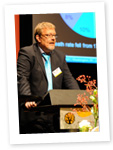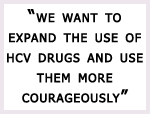Hepatitis C: novel and future treatment strategies - an interview with Prof. Rockstroh
 Q. Could you please tell us where you currently work and what work you carry out?
Q. Could you please tell us where you currently work and what work you carry out?
Currently, I work at the HIV clinic at the Department of Medicine, University of Bonn in Germany. We have a large HIV cohort of around a 1,000 patients and our major research and focus is on hepatitis co-infection. Around 300 of our patients have hepatitis C (HCV) co-infection, which is much higher than the overall German prevalence of 15%. The largest group of patients we have, and the reason why the HIV treatment centre in Bonn was founded, are haemophiliacs. When we tested haemophiliacs for HIV in 1984, out of 820 patients, 420 tested HIV-positive. This led to the Internal Medicine department taking over the HIV care and is the reason why we are now a HIC centre.
Q. What are your current areas of research?
My department’s current area of research is HIV/HCV co-infection, where we focus on both acute and chronic HCV. Because of our co-infection interest and expertise we handle the acute HCV epidemic among HIV-positive men who have sex with men (MSM)  in Germany. As such we have built a network and set up an acute HCV cohort, with both retrospective and prospective data. With this cohort we can do all kinds of immunological and virological studies. We are, for example, looking at the clearance of acute HCV, the occurrence of spontaneous polymorphism and genetic evolution of the virus in the patient, and treatment outcome and which factors predict cure of acute HCV.
in Germany. As such we have built a network and set up an acute HCV cohort, with both retrospective and prospective data. With this cohort we can do all kinds of immunological and virological studies. We are, for example, looking at the clearance of acute HCV, the occurrence of spontaneous polymorphism and genetic evolution of the virus in the patient, and treatment outcome and which factors predict cure of acute HCV.
For chronic HCV we have focused on development of new treatment strategies and new direct acting antiretroviral-based (DAA-based) therapies including interferon-free options for treatment of HCV and HIV.
Q. At NCHIV you will present on HCV/HIV co-infections: novel and future treatment strategies. Could you discuss the treatments currently available and why the new medications currently in development are so exciting?
Current treatment options for patients with HCV genotypes 2, 3 and 4 still depend on peg-interferon and ribavirin. Only for genotype 1 do we now have a first DAA-based therapy including a HCV protease inhibitor, either telaprevir of boceprevir, but still in combination with peg-interferon and ribavirin. The limitations of these therapies are the interferon-associated side effects, and that for the HIV-infected patients, who have longer treatment durations of up to 72 weeks with an interferon/ribavirin-only treatment or 48 weeks with a triple-based therapy, no response guided treatment approaches have been published.
The future, therefore, is exciting for two reasons. Firstly, because although the initial triple-based therapy has offered substantially increased cure rates of around 75% in genotype 1 patients, the high pill burden and side effects are still limiting; clearly the introduction of new compounds such as once-daily DAAs will allow much shorter treatment durations and better results. Secondly, the results of the first peg-interferon free regimen in HIV/HCV co-infected patients was presented, showing cure rates of 76% in patients with genotype 1, 88% in patients with genotype 2, and the lowest response rate of 67% in patients with genotype 3. As soon as this new regimen, consisting of sofosbuvir and ribavirin, becomes licenced it will become the first all-oral therapy for treatment of genotype 2. In 2 years from now we will see the introduction of fixed-dose combinations which will allow use of DAA combinations in more challenging patients which are difficult to treat.
Q. Things will certainly improve with the introduction of these new medications, but what do you see will be the main challenges following their introduction?
I believe the main challenge will be the cost issue. I think in the future it will eventually all be about how many drugs we need for whom. This will be particularly important in the context of very expensive therapies, as you don’t want to use more drugs than necessary in order to keep costs down. Unfortunately, all HCV drugs will have high associated costs, which will represent a huge burden in the uptake of these therapies throughout the world. Especially in regions where there is not enough money for these treatments we will get an inequity of treatment. We already have seen that in countries that are more struck by the euro crisis, hospitals have limited the drugs to special patient populations only. We want to expand the use of these drugs and use them more courageously, but there are definitely going to be budget limitations allowing us to do so.
I think the only way forward is that, just like in HIV, alternative strategies are sought and that we have to fight for patents being given to generic companies for producing inexpensive products that could be given to countries where they will be unable to pay a hundred thousand euros per patient.
The second limitation is that many studies have been conducted in more favourable patient populations. What we need is more data on patients with the highest risk of disease progression (those with advanced fibrosis, a history of decompensation, previous non-responders or genotype 1 and 3). Then we can understand how can we treat these patients. For example, we already know that sofosbuvir and ribavirin in genotype 3 patients with cirrhosis works only in around 30% of the patients, so there are identifiable groups that remain difficult to treat. The important question will remain which combinations can we use for whom and how can we identify and develop good algorithms for treatment plans.
» Watch the webcast of Prof. Rockstroh's presentation
» Download the NCHIV presentation of Prof. Rockstroh
